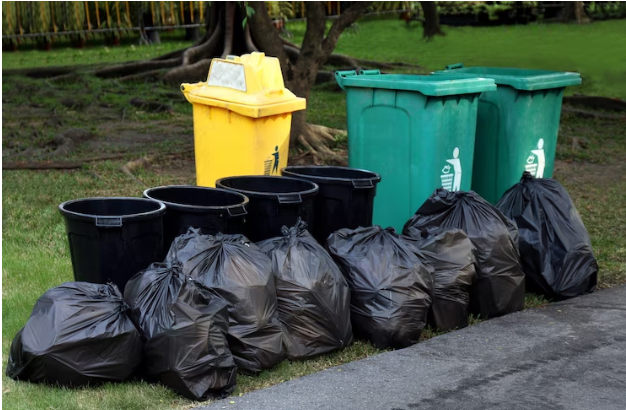In industrial settings, effective waste management is essential for maintaining cleanliness, hygiene, and operational efficiency. Industrial bin liners play a crucial role in this process, providing a reliable containment solution for various types of waste generated in manufacturing facilities, warehouses, construction sites, and other industrial environments.
By enhancing waste management efficiency, industrial bin liners contribute to a safer, cleaner, and more sustainable workplace. In this article, we’ll explore the significance of industrial bin liners and how they improve waste management practices in industrial settings.
Understanding Industrial Bin Liners
Industrial bin liners are heavy-duty bags designed to line and contain waste in large bins, dumpsters, or containers commonly found in industrial facilities.
These liners are constructed from durable materials such as high-density polyethylene (HDPE) or low-density polyethylene (LDPE), which offer strength, puncture resistance, and tear resistance to withstand the rigors of industrial waste handling.
Types of Industrial Bin Liners
Industrial bin liners come in various types and sizes to accommodate different waste volumes, types, and disposal requirements. Some common types of industrial bin liners include:
- Heavy-Duty Liners: Designed for handling bulky or sharp-edged waste materials, such as metal scraps, construction debris, or industrial packaging.
- Chemical-Resistant Liners: Constructed from specialized materials to withstand exposure to hazardous chemicals or liquids without degradation or leakage.
- High-Temperature Liners: Engineered to withstand high temperatures generated during processes such as welding, metal fabrication, or industrial cooking.
- Anti-Static Liners: Designed to prevent the buildup of static electricity, which can pose safety hazards when handling electronic components or flammable materials.
- Biohazard Liners: Specifically designed for containing biohazardous waste materials, such as medical waste or laboratory specimens, to minimize the risk of contamination or infection.
Benefits of Industrial Bin Liners
Waste Containment and Segregation
One of the primary functions of industrial bin liners is to contain and segregate different types of waste, preventing cross-contamination and facilitating proper disposal.
By lining industrial bins or containers with appropriate liners, businesses can organize and manage various waste streams more effectively, ensuring compliance with regulatory requirements and minimizing environmental impact.
Protection of Containers
Industrial bin liners serve as a protective barrier for containers, shielding them from damage, corrosion, or contamination caused by corrosive or abrasive waste materials. By preserving the integrity of containers, bin liners extend their lifespan and reduce the need for frequent replacement or maintenance, resulting in cost savings and operational efficiency gains.
Improved Hygiene and Safety
Proper waste containment with industrial bin liners helps maintain a clean and hygienic work environment, reducing the risk of pest infestations, odors, and the spread of disease-causing pathogens. Additionally, industrial bin liners can contain spills, leaks, or hazardous materials, preventing workplace accidents, injuries, and environmental contamination.
Enhanced Efficiency in Waste Handling
Industrial bin liners streamline waste handling processes by facilitating quick and easy disposal of waste materials. With liners in place, workers can simply tie off filled liners and replace them with fresh ones, minimizing downtime and labor requirements associated with cleaning or decontaminating bins. This efficiency improvement translates into increased productivity and reduced operational costs for industrial facilities.
Choosing the Right Industrial Bin Liners
Consideration of Waste Types and Characteristics
When selecting industrial bin liners, it’s essential to consider the types and characteristics of the waste materials being handled. Different waste streams may require specialized liners designed to withstand specific conditions or hazards. Conduct a thorough assessment of your facility’s waste streams and consult with suppliers to determine the most suitable bin liner options for your needs.
Size and Capacity
Industrial bin liners come in various sizes and capacities to accommodate different bin or container dimensions and waste volumes. Choose liners that match the size and capacity of your bins to ensure proper fit and containment. Oversized liners may result in unnecessary material waste and increased costs, while undersized liners may compromise containment effectiveness and safety.
Durability and Strength
Select industrial bin liners with sufficient durability and strength to withstand the demands of your waste handling processes. Consider the weight, density, and sharpness of the waste materials being disposed of, as well as any potential exposure to chemicals, heat, or other hazards. Look for liners made from high-quality materials and with reinforced seams or gussets for added strength and reliability.
Implementing Industrial Bin Liners in Your Facility
Employee Training and Education
Introduce industrial bin liners into your waste management processes through comprehensive employee training and education programs. Ensure that workers understand the importance of proper waste handling and the correct use of bin liners to maximize effectiveness and safety. Provide clear instructions on how to select, install, and dispose of bin liners according to established procedures and best practices.
Regular Maintenance and Inspection
Establish a routine maintenance and inspection schedule to monitor the condition of industrial bin liners and containers. Inspect liners for signs of damage, wear, or contamination, and replace them as needed to prevent leaks or spills. Clean and sanitize bins and containers regularly to maintain hygiene standards and prolong their lifespan.
Compliance with Regulations
Stay informed about regulatory requirements governing waste management, handling, and disposal in your industry or region. Ensure that your use of industrial bin liners complies with applicable regulations, standards, and guidelines to avoid fines, penalties, or legal liabilities. Maintain accurate records of waste handling activities and disposal practices to demonstrate compliance during inspections or audits.
Conclusion
Industrial bin liners play a vital role in enhancing waste management efficiency and promoting a cleaner, safer, and more sustainable workplace. By containing and segregating waste materials, protecting containers, and improving hygiene and safety, industrial bin liners contribute to operational efficiency gains and cost savings for industrial facilities.
By choosing the right bin liners and implementing best practices in waste handling, businesses can optimize their waste management processes and minimize environmental impact. Make the smart choice for your industrial facility by investing in quality industrial bin liners and reaping the benefits of improved efficiency and effectiveness in waste management.
